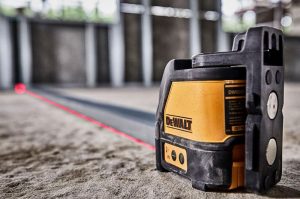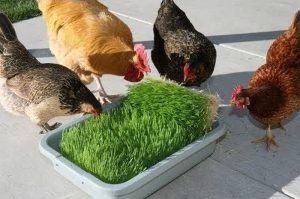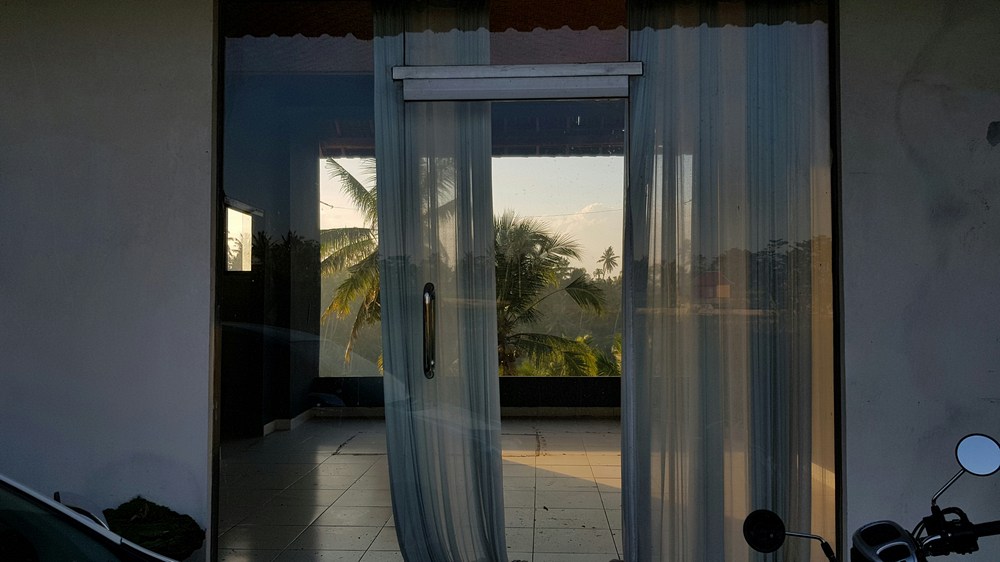Last Updated on March 22, 2024 by teamobn
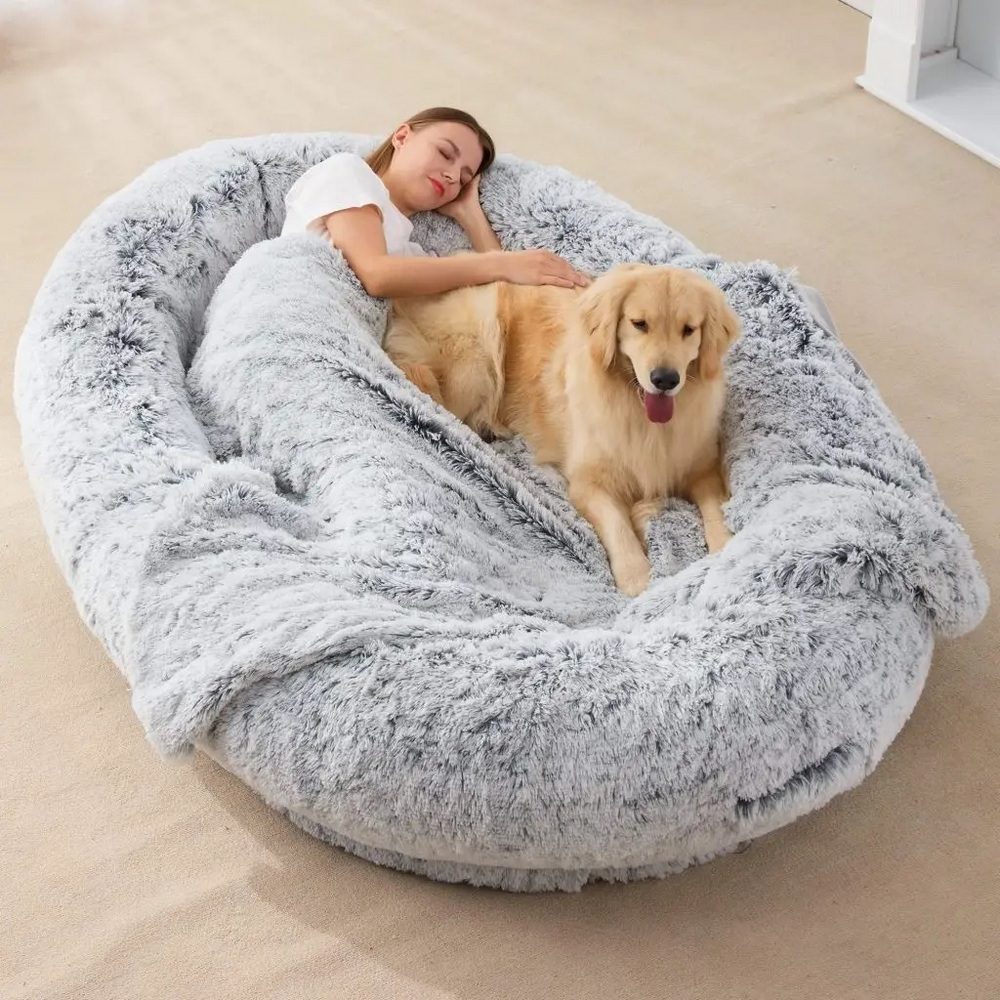
For DIY enthusiasts, creating a human dog bed is an innovative project that combines comfort for pets and their owners. This article explores how to build a human dog bed, a unique addition to any home renovation. The focus on these beds will prioritize the comfort and safety of you and your pets.
Contents
What are Human Dog Beds?
The concept of human dog beds in DIY is a unique and innovative approach to creating a space that caters to the comfort of pets and their owners. This intuitive dog bed design has gained popularity among DIY enthusiasts who seek to blend functionality with personal style in their home projects.
The idea is for a human dog bed is to be large enough for an adult human to lie comfortably, yet cozy and inviting for dogs, embodying a shared space that strengthens the bond between pet and owner.
Background on Plufl
The human dog bed concept was notably brought into the mainstream by Plufl, the first of its kind that garnered widespread attention after appearing on the popular TV show “Shark Tank.” Founded by Noah Silverman and Yuki Kinoshita, Plufl revolutionized how we think about pet furniture.
Their design, which looks like an oversized traditional dog bed, is intended to provide a comfortable space for humans and dogs to relax and connect. The Plufl bed features a unique oval shape, soft padding, and a design that ensures comfort and safety for both parties.
Silverman and Kinoshita’s innovation was inspired by their observation of the deep emotional connections people have with their pets. They noticed that many pet owners enjoy lounging and relaxing with their pets but often find typical pet beds too small and uncomfortable for human use.
Thus, the idea of the Plufl – a human-sized dog bed, was born. This concept challenged traditional pet furniture designs and opened new possibilities for pet-friendly home accessories.
DIY Approach to Human Dog Beds
The DIY approach to building a human dog bed allows for customization and creativity. It offers the opportunity to design a bed that fits the aesthetic of one’s home but also caters to the specific needs and preferences of both the pet and the owner. When undertaking such a project, there are several factors to consider:
- Size and Shape: The bed should be large enough to comfortably accommodate an adult human and their pet. The shape can vary from the traditional oval, as seen in the Plufl, to other shapes like rectangular or circular, depending on space availability and personal preference.
- Comfort: Comfort is paramount. It involves selecting the right padding and cushioning to provide support and coziness. Memory foam is a popular choice due to its durability and comfort level.
- Materials: The choice of materials is crucial for both durability and comfort. Fabrics should be soft yet durable and able to withstand regular use. It’s important to consider pet-friendly materials that are easy to clean and resistant to wear and tear.
- Safety: A priority is ensuring the bed is safe for humans and pets. Safety considerations include ensuring no sharp edges, the structure is stable, and the materials used are non-toxic.
- Design: The design aspect allows DIY builders to get creative. It includes choosing colors and patterns and adding personal touches like a pet’s name or decorative elements matching the home’s décor.
- Functionality: A DIY human dog bed should be practical. It should be easy to move if needed, fit well within the chosen space, and be simple to clean and maintain.
The DIY human dog bed is more than just a piece of furniture; it’s a testament to the love and bond shared between a pet and their owner. Taking inspiration from pioneers like Plufl’s founders, DIY builders can create a space that is functional and reflects the special relationship they share with their pets. In doing so, they can transform a simple concept into a meaningful addition to their home.
Planning Your Human Dog Bed
Planning your DIY human dog bed project requires thoughtful consideration and careful preparation. This stage is crucial as it lays the foundation for a successful build. By focusing on key aspects such as design, space, and materials, you can ensure that the finished bed is functional and aesthetically pleasing.
Design Considerations
Start by assessing the space where you will place the bed. Consider the size of the room and the bed’s positioning to ensure it blends seamlessly with your home décor. Think about the shape and size that suit your and your pet’s needs. Whether it’s an oval like the Plufl or a more traditional rectangle, the design should facilitate comfort and accessibility for you and your pet.
Space and Functionality
Your human dog bed size should be adequate to accommodate you and your pet comfortably. However, it’s important to balance this with the available space in your home. A bed that’s too large can overwhelm a small room, while one that’s too small defeats the purpose of shared comfort. Additionally, consider how the bed will be used: Will it be a permanent fixture in your living room, or do you need the flexibility to move it around?
Material Selection
The choice of materials is critical in a DIY human dog bed. Opt for durable, pet-friendly fabrics that are easy to clean and maintain. Memory foam is an excellent choice for cushioning due to its comfort and longevity. Materials like wood or high-density foam provide stability and support for the frame and base. Also, consider hypoallergenic materials if you or your pet have sensitivities.
Customization
Customization is where you can get creative. Customize the bed to suit your pet’s personality and your home’s style. Choose fabrics and colors that complement your interior décor. You can add unique elements like a removable cover for easy washing or special compartments for storing pet toys.
Planning your DIY human dog bed project sets the stage for a successful build. By focusing on design, space, material selection, safety, and customization, you can create a bed that is a comfortable retreat for your pet and a stylish addition to your home.
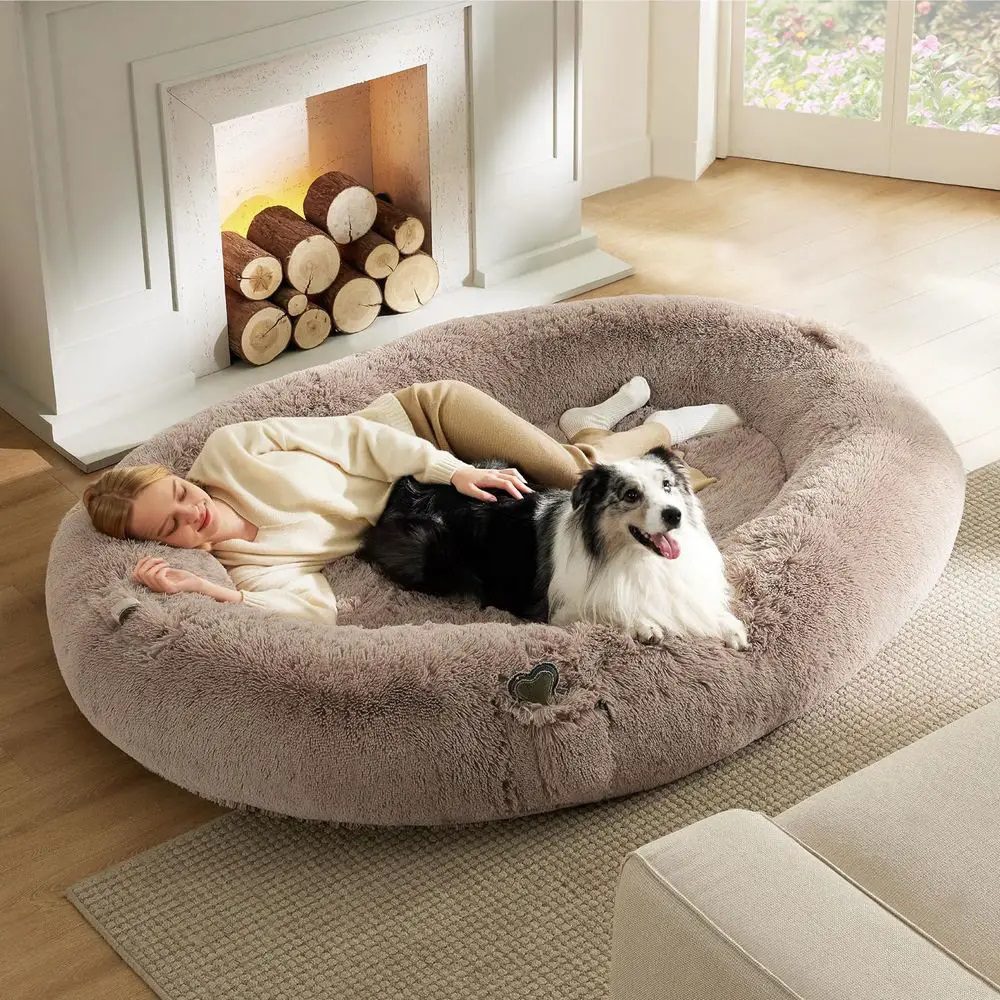
Step-by-Step Building Guide on Human Dog Bed
Building a DIY human dog bed can be rewarding, allowing you to create a unique and comfortable space for you and your pet. Follow this step-by-step guide to ensure a smooth building process.
Step 1: Design and Measurements
Begin by sketching your human dog bed design, keeping in mind the dimensions of your space and the size requirements for you and your pet. Measure the area where you plan to place the bed to determine the maximum size it can be. This step is crucial to ensure the bed fits comfortably in your designated space.
Step 2: Cutting the Frame
Cut the plywood or solid wood using your measurements to create the bed frame. Depending on your design, this will typically involve cutting a base, sides, and possibly a backrest. Ensure all pieces are cut accurately and fit together well.
Step 3: Assembling the Frame
Assemble the frame using screws and nails. Start by attaching the sides to the base. If your design includes a backrest or additional elements, attach them accordingly. Use the drill to make pilot holes to avoid splitting the wood, then secure the pieces together.
Step 4: Sanding
Once the frame is assembled, sandpaper smooths all surfaces, edges, and corners. This step is crucial for safety and to prepare the wood for any paint or finish you might want to apply.
Step 5: Painting or Staining (Optional)
If you wish to paint or stain the wood, now is the time. Choose a non-toxic paint or stain and apply it evenly. Allow it to dry completely before proceeding.
Step 6: Preparing the Cushion
Measure and cut the memory foam or high-density foam to fit the frame. The cushion should be thick enough to comfort you and your pet.
Step 7: Sewing the Fabric Cover
Measure and cut the cover fabric, allowing extra seam allowances. Sew the fabric into a cover that snugly fits over the cushion. Consider adding a zipper or Velcro for easy removal and cleaning.
Step 8: Assembling the Bed
Place the cushion inside the frame. If you’ve made a removable cover, put it on the cushion. Use the staple gun to secure any loose fabric underneath the bed.
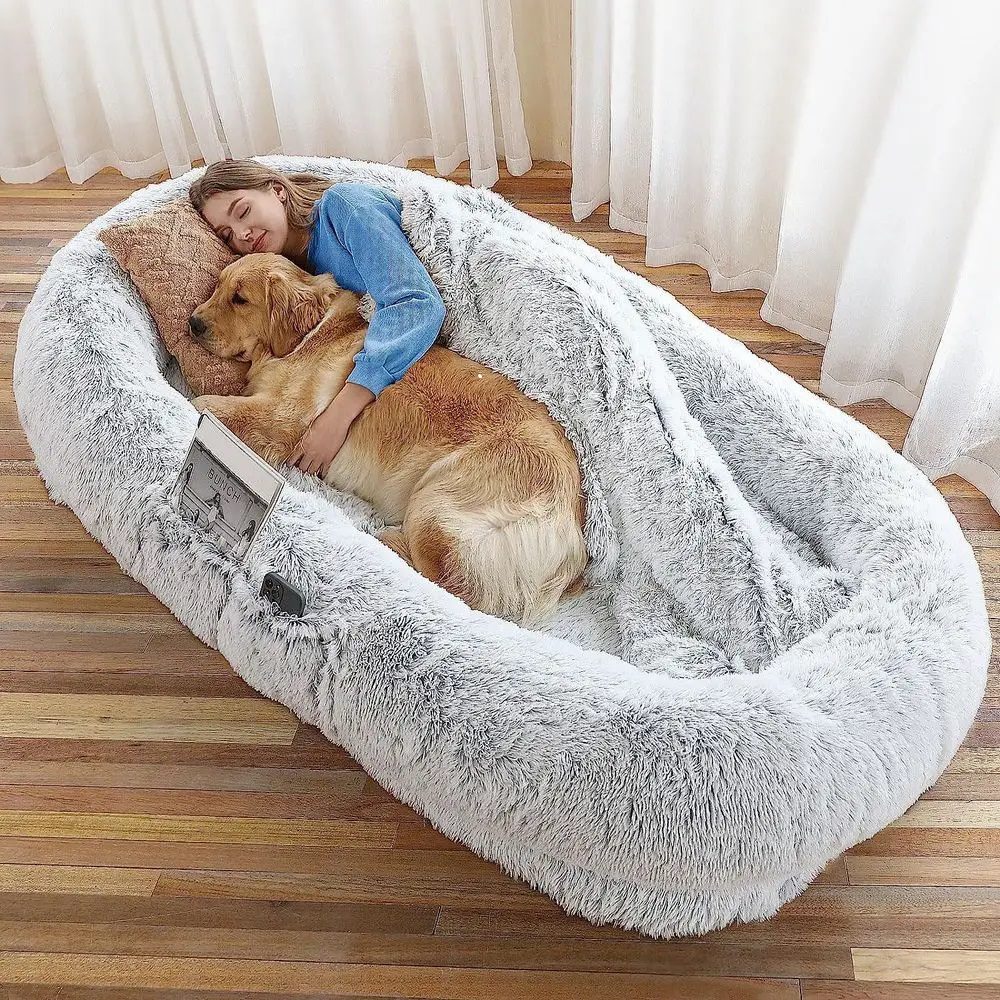
Step 9: Adding Final Touches
Add any final touches to your bed, such as decorative pillows, blankets, or even a name tag for your pet. These personal touches can make the bed more inviting and special.
Step 10: Placement and Testing
Place the bed in its designated spot and invite your pet to test it. Make sure it’s comfortable for both you and your pet. Observe how your pet interacts with the bed and make any necessary adjustments.
Human Dog Bed Safety and Comfort
When creating a DIY human dog bed, safety and comfort are paramount. This section of your project ensures the bed is a secure and cozy space for you and your pet.
Ensuring Structural Stability
- Robust Frame: The bed’s frame should be sturdy enough to support the weight of an adult human and a pet. Use high-quality, durable materials for the frame, and ensure all joints are securely fastened with screws or nails.
- Smooth Edges: Sand all edges and corners of the bed thoroughly. This prevents the risk of scratches or injuries from sharp or rough surfaces.
- Non-Toxic Materials: Use only non-toxic materials, especially paint, stains, and adhesives. Pets often chew or lick surfaces, and it’s vital to ensure their safety by avoiding harmful substances.
- Secure Cushioning: The cushion should fit snugly within the frame without any risk of slipping out. Attach the cushion to the frame using Velcro strips or a similar method to keep it in place.
Maximizing Comfort
- Quality Cushioning: The cushioning is a key element of the bed’s comfort. Memory or high-density foam provides excellent support and comfort for you and your pet. The cushion should be thick enough to prevent feeling the hard base underneath.
- Soft, Durable Fabric: Choose a fabric that is soft to the touch yet durable enough to withstand regular use and cleaning. Fabrics that are easy to wash and resistant to pet hair and odors are ideal.
- Adequate Space: Ensure the bed is spacious enough for you and your pet to relax without feeling cramped. There should be enough room to move around and settle comfortably.
- Temperature Regulation: Consider the bed’s placement of heat sources or drafts. The bed should be in a spot that maintains a comfortable temperature throughout the year.
- Personal Touches: Adding elements like soft blankets or your pet’s favorite toys can make the bed more inviting. This enhances comfort and helps your pet feel more at home in the new space.
Maintenance and Upkeep of Your Human Dog Bed
Maintaining and upkeeping your DIY human dog bed is essential to ensure its longevity and ongoing comfort. A well-maintained bed remains a safe and inviting space for you and your pet. Here are key aspects to consider for the maintenance and upkeep of your human dog bed.
Routine Cleaning
- Removable Covers: If you’ve designed your bed with removable covers, wash them regularly. Follow the fabric’s care instructions to prevent shrinkage or damage.
- Vacuuming: Regularly vacuum the bed to remove pet hair, dust, and dander. This is especially important for pet owners with allergies.
- Spot Cleaning: For small stains or spills, spot-clean the fabric immediately. Use a mild, pet-safe detergent and ensure the area is completely dry after cleaning.
- Deodorizing: To keep the bed smelling fresh, use pet-safe deodorizing sprays or sprinkle baking soda on the cushion, letting it sit for a few hours before vacuuming it.
Inspecting and Repairing
- Structural Checks: Periodically check the bed’s frame for loose screws or weak joints. Tighten or repair as necessary to maintain the bed’s stability.
- Fabric and Seam Integrity: Inspect the fabric for tears or seam rips. Repair or replace the fabric if it becomes too worn or damaged.
- Cushion Condition: Over time, the cushioning may become flat or lumpy. Check the cushion and add or replace the foam if it loses its support or comfort.
Protecting the Bed
- Positioning: Place the bed where it’s less likely to be damaged. Avoid direct sunlight, which can fade the fabric, and keep it away from high-traffic areas to reduce wear.
- Waterproof Liners: Consider using a waterproof liner between the cover and the cushion to protect the foam from accidents or spills.
- Pet Grooming: Regular grooming of your pet can reduce the amount of hair and dander accumulating in the bed. This includes brushing and, if applicable, regular baths.
Upgrades and Enhancements
- Refresh the Design: Occasionally, you might want to update the bed’s look. This can be as simple as sewing new covers or adding new decorative elements.
- Comfort Enhancements: Add additional comfort features like extra pillows, bolster sides, or a new layer of more supportive foam.
- Seasonal Adjustments: Depending on the season, you might add warmer blankets for the winter or opt for cooler, breathable fabrics for the summer.
Regular maintenance and upkeep not only prolong the life of your human dog bed but also ensure it remains a comfortable and hygienic space for your pet and you. By dedicating time to routine care and occasional enhancements, your DIY project will continue to be a valuable and cherished part of your home.
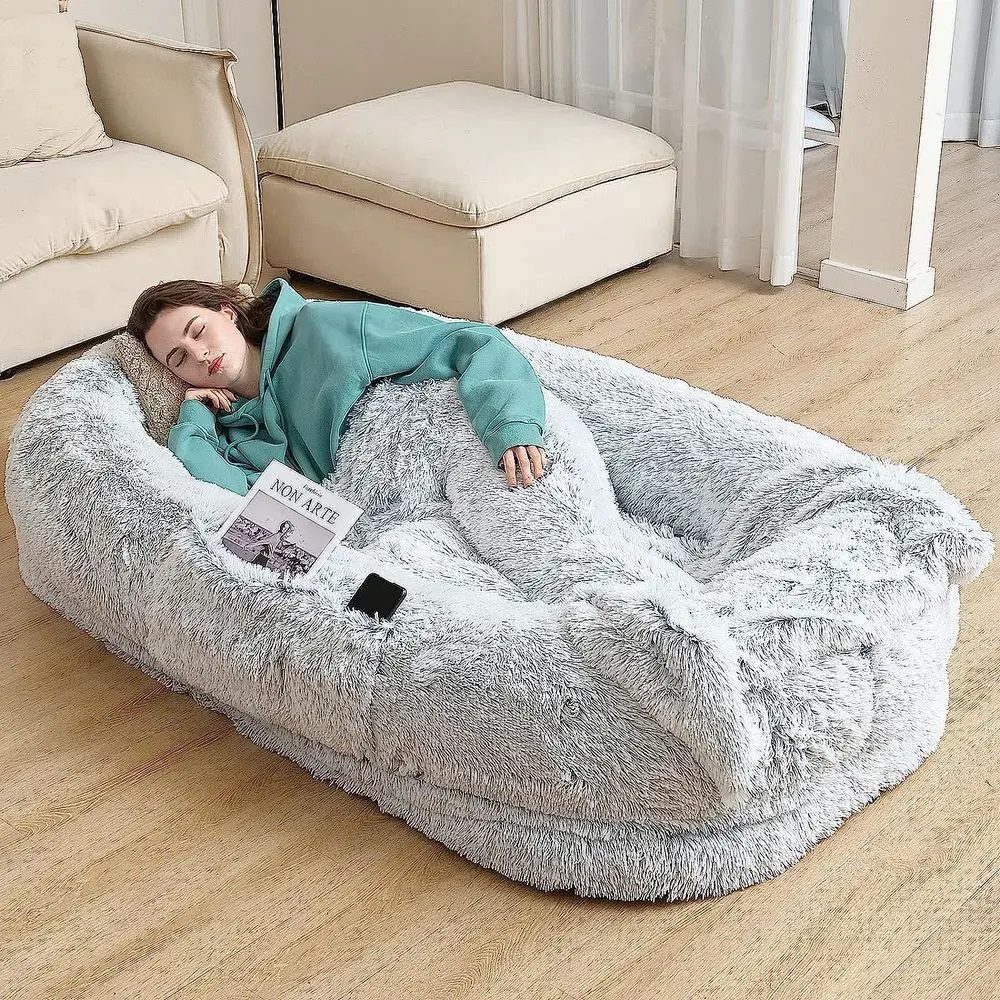
Buying a Premade Human Dog Bed
Buying a premade human dog bed offers significant benefits for homeowners, especially those who may not have the time or skills for a DIY project. These beds provide the same level of comfort and bonding opportunity with your pet but come with the convenience of being ready to use.
Purchasing a premade bed also ensures professional quality regarding materials, durability, and safety standards. Here, we will explore three top human dog beds available on Amazon, including the notable Plufl.
Plufl – The Original Human Dog Bed
The Plufl stands out as the original human dog bed, gaining fame from its appearance on “Shark Tank”. It’s designed with both pet and owner comfort in mind, featuring a unique oval shape miming traditional dog beds but on a larger scale.
This Human Dog Bed is crafted with premium materials, including a memory foam base for optimal comfort and a soft, durable cover that is easy to remove and wash. The generous bed’s size allows ample space for pets and their owners to relax together.
The standout feature of the Plufl is its design, which fosters a deeper bond between pets and their owners. It’s also a stylish piece that seamlessly blends into any home decor, making it a functional and attractive addition to any living space.
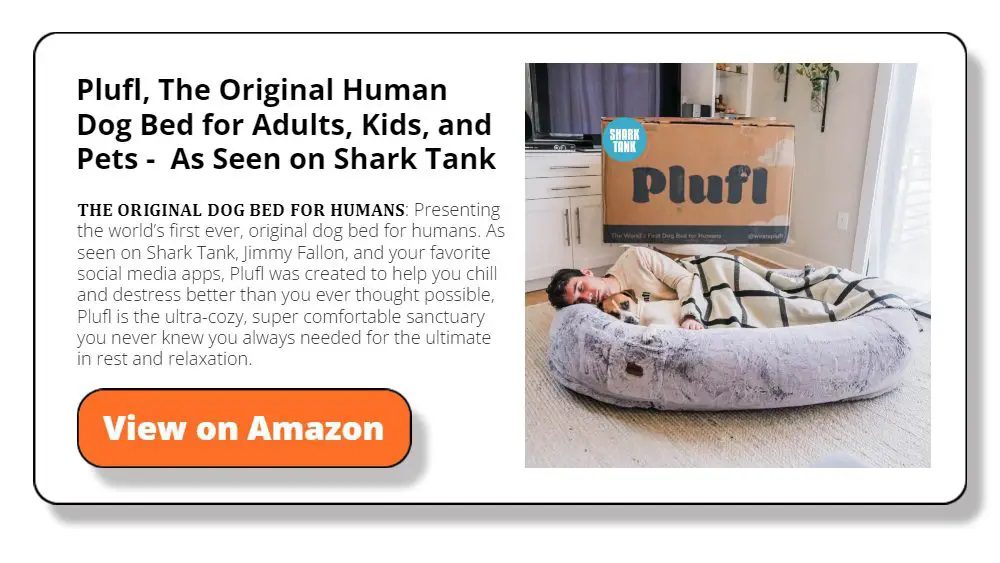
Bedsure – Humans Dog Bed for Adults
The Bedsure Human Dog Bed is a versatile and spacious option to provide unparalleled comfort for humans and pets. Its portable nature suits various settings, from indoor lounging to outdoor adventures.
This bed includes orthopedic support with a combination of memory foam and high-density support foam, distributing weight evenly and offering joint support. The calming bolster design adds to its comfort, with a cushioned bolster for head and neck support. A waterproof cover, easy maintenance, and safety certifications like CertiPUR-US and OEKO-TEX make it a practical choice.
Its spacious design and therapeutic support make it ideal for napping, reading, or playing with your pet. The bed’s design and material quality assure a comfortable and safe experience, providing security and ease of care.
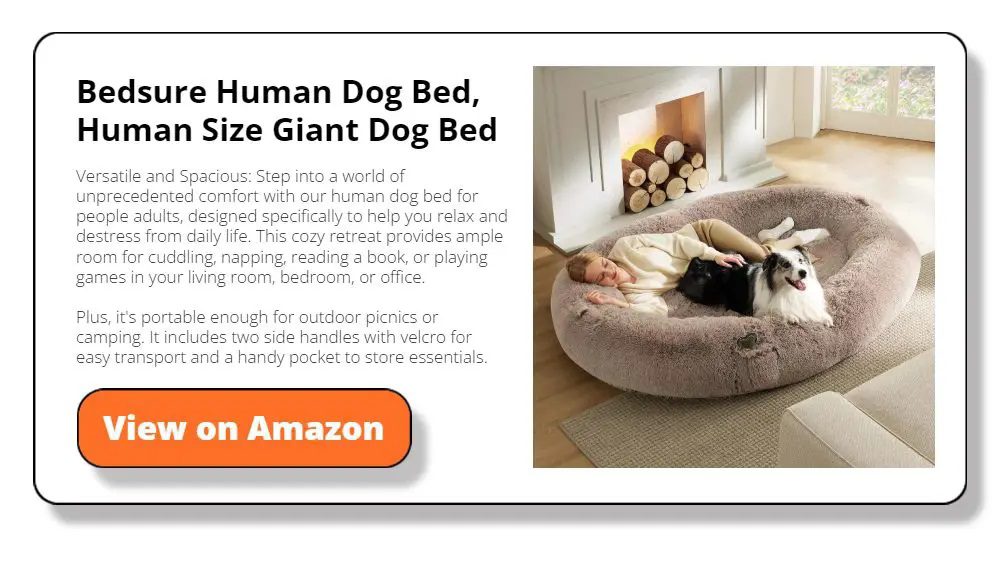
Wros – Washable Human Dog Bed
The WROS Human Dog Bed stands out for its embracing-like design, offering a sense of security and comfort reminiscent of a mother’s arms. It’s an excellent choice for those seeking a comfortable, secure resting space.
This bed features a premium faux fur plush cover, soft and warm, with a thick bolster for a cocoon-like experience. It includes practical additions like a storage pocket and a durable strap for easy storage. The non-slip rubber bottom ensures stability during use, and the package comes with a soft blanket, a plump pillow, and a durable strap.
The oversized surround and comfortable fabric provide a peaceful and warm environment, ideal for relaxation and anxiety relief. Its easy maintenance, washable cover, and simple care instructions add to its convenience.
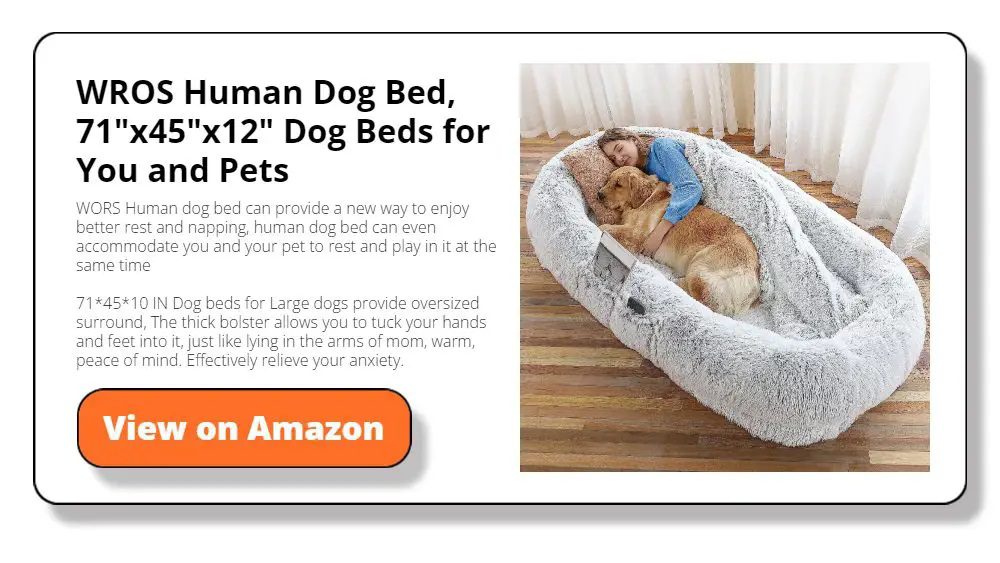
Conclusion
In conclusion, whether you embark on a DIY project to build a human dog bed or opt for a premade option, each path offers unique rewards. Choosing between DIY and buying premade depends on individual preferences, skills, and lifestyle requirements. Whichever route you choose, the goal is to create a comfortable, safe, and loving space where you and your pet can enjoy countless moments together.

